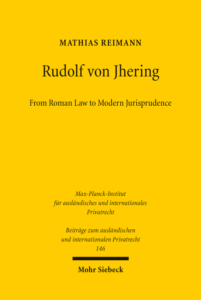Henry Goudy, Professor of Civil Law in the University of Edinburgh, and then Regius Professor of Civil Law in the University of Oxford, was educated in Scotland and then in Königsberg in Germany. From his period of study in Germany he retained close German friends. It is interesting that when he decided to translate a German legal work into English, he settled on Rudolf von Jhering’s Die Jurisprudenz des täglichen Lebens, first published in 1870, though its textual history is complex, as Jhering explained in his introduction. Goudy’s translation was published in 1904 as Law in Daily Life: A Collection of Legal Questions Connected with the Ordinary Events of Everyday Life. Just reading the work is stimulating and fascinating. The issues are tricky, but worthwhile. They are not for the intellectually faint hearted. They are stimulating not only as tricky legal problems, but also fascinating as having a now somewhat antiquated air, providing insights into a world that is both very like ours but also very different, a recent world that has vanished.
These thoughts are prompted by the recent appearance of Rudolf von Jhering: From Roman Law to Modern Jurisprudence by Mathias Reimann, published by Mohr Siebeck (2025). A short Blog entry is not the place for a review, but it is a fascinating book that I certainly found compelling to dip into as soon as I picked it up. What is interesting is the largely chronological nature of the approach, tracing Jhering’s continuous intellectual development and change, placed against the evolution of legal thought in nineteenth-century Germany. Contradictions, inconsistencies, and changes are acknowledged. It is a rich, worthwhile, and thought-provoking study. One also gains a sense of Jhering the man. Goudy in his introduction to his translation states that it is important not to divorce the theoretical from the practical, and this is, of course, one of the themes of Jhering’s thought that comes through Reimann’s work. It is interesting to read of Jhering’s commitment to teaching (also a concern of his translator), in which he paid “little attention to a systematic exposition of the material”. One fears he might fall foul of the tenets of the British Teaching Excellence Framework. But he was a successful teacher, who took the task very seriously.
Given that Jhering adopted what was essentially a sociological position on law, it is worth noting that it was Eugen Ehrlich, another rich and complex thinker, who also developed a sociological approach, who translated Goudy’s Trichotomy in Roman Law, published in 1914 as Dreiteiligkeit im römischen Recht. One suspects that Ehrlich liked Goudy’s search for an understanding not be found in dogmatic legal reasoning.
It is interesting that this new study of Jhering is published by a German comparative lawyer who has had a distinguished career in the U.S.A. American scholars have often tended to reduce Jhering and, for that matter, Ehrlich, to forerunners of American Legal Realism. Reimann eschews such trivialisation: Jhering is presented with all his tensions, contradictions, and multiple dimensions, and with his view that phenomena were best understood when approached from a variety of perspectives, and that adopting extreme positions was helpful, even if later proved wrong. The picture presented is attractive (the photograph facing the title page is of a warm and friendly man). He was clearly a man of flesh and blood who relished life. He remembered in all ways to follow the adage: carpe diem.


